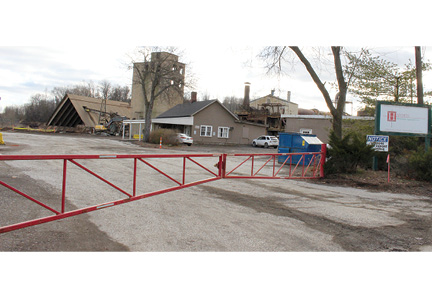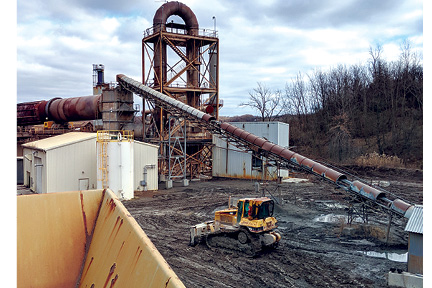Haydite mine closure means property at bottom of Stone Road will become parkland
by Erica Peterson
DiGeronimo Aggregates ceased operations at the haydite mine at the bottom of Stone Road, closing the longest continually operating business in the city.
The property will get a second life as a recreation area, however, when it is donated to the National Park Service as part of a 20-year-old agreement.
Mayor Anthony Togliatti told city council at its Dec. 11 meeting that as of Jan. 1, DiGeronimo would close the mine, which dates to the 1870s and is one of the largest open strip mines in the state.
“With the closure of the mine, I feel as though a piece of Independence history is being lost, as Independence began as a mining and quarrying village,” Togliatti said.

The closure will “come as a pleasant surprise to the residents of Stone Road, as the truck traffic, dust and blasting will come to a halt,” he said.
Residents have complained for years about the volume of heavy trucks on the winding residential road, as well as mud, dust and diesel exhaust from the trucks and the periodic blasting at the mine. Stone Road’s speed limit was reduced to 10 mph due to the trucks.
The traffic won’t stop immediately, Togliatti said. Trucks will continue going to and from the property for the next year or two as part of the six-year reclamation period, when the property will be returned to its natural state. That will involve razing structures and grading the land around the mining pit, which will be allowed to fill in with water.
Law Director Greg O’Brien told council that the city purchased around 32 acres of mine property in 1995 as part of a legal settlement to prevent the area from being turned into a landfill. The Hydraulic Press Brick Co. owned around 65 acres and operated the mine at the time.
The city agreed to lease back the property to Hydraulic to use as part of the mine operation, he said.
“And when that mining ceased, the city’s property … would be donated to the U.S. Park Service,” O’Brien said. “[Hydraulic] and the city and the U.S. Park Service agreed on a restoration agreement which was incorporated in the lease agreement.”
Hydraulic also entered into a perpetual recreation agreement with the National Park Service, agreeing that its portion of the property would be reclaimed, too.

According to that agreement, the land would be made available to Cuyahoga Valley National Park visitors as a recreational area, he said.
DiGeronimo Aggregates agreed to those same lease stipulations when it purchased the mine in 2004, O’Brien said. It has provided a $500,000 bond to cover the cost of the reclamation process, which is estimated at $330,000, he said.
Per an agreement with DiGeronimo, the West Creek Preservation Committee will act as the steward of the property during the process.
“West Creek has six years to restore the property in accordance with the restoration agreement,” O’Brien said. “The pit will fill in. It will be a lake.”
The lake should take two to three years to fill in, he said.
“Restoration, given that broad term, is essentially going in there and moving dirt around, sloping it and seeding it and making sure there are flat areas around the lake which will naturally fill in” to make the land usable for recreation, he said.
History of mine
Former council member Bob Wagner has studied the mine extensively. He said he wonders if most residents know that haydite, a lightweight aggregate made from clay, shale and slate, has been produced in their backyards for more than a century.
“DiGeronimo Aggregates has operated a world-class quarrying operation within our great city with scarcely little residential awareness, yet with worldwide demand,” he said.
Shale would be “sheered from the side of the quarry wall, like cutting a slice of bread from a loaf,” Wagner said, through a series of small explosive charges.
“The process entirely eliminated the use of larger explosive charges,” he said. “Typically, monthly blasting was conducted to sheer sufficient shale to support the next 30 days of production.”
The shale would be heated to 2,000 degrees in a 200-foot-long, 13-foot-diameter rotating kiln, Wagner said. Processing the shale in this way hardens it, making a strong and lightweight product highly desirable for a variety of construction products.
Red haydite granules were also produced, which are used on athletic fields, including the Cleveland Indians infield.
Mining and quarrying goes back to the very beginnings of Independence, which started as agrarian community with small subsistence farms, said Pam Dengler, president of the Independence Historical Society.
Its sandstone first put it on the map.
“The area got its first big economic boom through quarrying,” Dengler said.
Evidence of that local sandstone can be seen on the Bramley Home and the Independence Presbyterian Church, she said.
The haydite shale mine began operations in the late 1870s, Dengler said. At the time, it was used to make lightweight bricks.
The sandstone and haydite operations enabled the community to economically support itself.
“Of lasting importance to Independence was the revenue from the quarrying industry, which allowed Independence to stand alone in its formative years as a separate town, without having to merge with other towns for schools, police, fire and services,” Wagner said. “It gave us the financial means to be the independent city we call Independence.”
Dengler said records and other historic documents from the mine will be given to the historical society. “We are going to document this process as best we can,” she said, as the mine represents a significant part of Independence’s history. Wagner, too, said the closing of the mine closes “a historic chapter in the city’s history.” But, he said, the DiGeronimo family’s decision “to donate the entire acreage to the National Park Service after returning to a natural state for recreational use will open another lasting chapter for all to enjoy the forest’s natural beauty.”
Featured image photo caption: DiGeronimo Aggregates set off the last blast at its haydite mine Dec. 18 before closing the mine Jan. 1. The land at the bottom of Stone Road will be donated to the national parks, ending the 150-year mining operation that was essential to Independence’s beginnings. Photo by Kyle Collins

